Welcome back! Last week, we talked about makeup and whether it’s safe for children. If you missed that blog and would like to catch up, click HERE.
This week, we are going to talk about spiders, specifically which ones bite, which ones don’t, and what they all contribute to our world. So before you squish another spider, let’s chat…
It’s a good lesson for all
I once had a mentor tell me, “LINDA…slow down. STOP. THINK. RESPOND”. They did me a huge service by saying that to me. I’m rather impulsive. It has always helped me to follow this advice when I feel myself sinking into a fight or flight mode. Don’t REACT…RESPOND. There’s a difference. One is well thought out, the other is the result of adrenaline.
Why are we afraid of a spider?
Lots of good, solid reasons. Because it was role-modeled for us growing up. Because we got bit, or know someone who did, and it created a huge health scare for them. Because we don’t like being startled. Because … well…bugs. Ew.
So I’m going to challenge you to stop, think, and respond the next time you see a spider. Let’s start with the STOP.
STOP
This means what it says. Just stop. Don’t do anything. Even if it runs up the wall, even if you miss a good opportunity to kill it, just stop and wait a few minutes until your adrenaline has worn off and you can THINK.
THINK
This is the long part. There’s a lot to learn and take in when it comes to spiders. I’m going to give you some things to think about before we end this blog.
Biggest fear
When I asked several people who are terrified of spiders why they are so scared, they said, “Some are poisonous and if they bite me I could die or lose a limb”. Fair enough. Let’s investigate those fears.
How many people die from spider bites every year in the US?
The answer varied according to my research, so I’ll go with the higher number. Six. Out of roughly 332 million people, only six die every year from spider bites.
How many people get flesh issues from bites?
The Wound Care Learning Network reported in one study, that 45% of patients diagnosed with a brown recluse spider bite presented with a necrotic lesion. However, a necrotic skin lesion is seen in only 8% of patients who present a spider for examination and in only 22% of patients who report seeing a spider around the time of injury. Because the presence of necrosis may lead to the erroneous diagnosis of brown recluse spider bite, the true frequency of necrosis is unknown.
But I can see their fangs!
Interesting fact from Boston Children’s Hospital: Most of the 20,000 species of spiders found in the United States are poisonous, but their fangs are too short or too fragile to break through human skin.
But some ARE poisonous…know which ones.
So…the large spider at the top of this blog? That’s a simple house spider. It’s not poisonous. It’s one of the good guys. Yes, he’s large. I measured one the other day which was 4 inches from toe to toe. It creeped me out. I offered him a glass to step into, and he did, and he stepped out onto my lawn. Problem solved. HOWEVER…I know my spiders. So should you.
Let’s ID the three main ones to watch out for…
Rutgers gave us some great information.
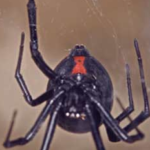
Let’s start with the Widow Spiders.
Widow spiders get their common name from the belief that the female eats the male after mating, which rarely happens in nature. They occur in every state in the United States. Five Latrodectus species occur in North America. The southern black widow (Latrodectus mactans) is the most notorious because of its potent venom, widespread occurrence, and likely contact with humans and domestic animals. It is found throughout North America, from southern New England to eastern Mexico. The southern black widow spider is recognized by its black color and red triangular marks that often form an hourglass-shaped marking on the underside of the abdomen. Young spiders (spiderlings) are primarily orange and white but become darker as they molt. Mature females are nearly ½ inch (13 mm) in body length, and males are about half that size.
Black widow spiders live under stones, in firewood piles, under decks, in hollow stumps and trees, and in rodent burrows. Indoors, they are found in garages, basements, and crawl spaces. In the spring, female black widow spiders deposit eggs in silken egg sacs. A female may produce up to 21 egg sacs, each with a few hundred eggs. After an 8–30 days incubation period, spiderlings emerge from eggs. The spiderlings molt 4–9 times and become adults the next spring. Black widow spiders build irregular webs in dark, hidden places.
Black widow spiders produce venom that contains a neurotoxin. Their bite causes pain radiating from the site of the bite. In severe cases, nausea, overall aching of the body, sweating, and labored breathing may occur. Symptoms will disappear after several hours to several days.
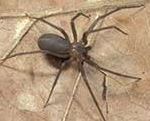
Recluse Spiders
Recluse spiders (genus Loxosceles) are notorious for their potent venom. Thirteen species are known to occur in the United States. Most Loxosceles are restricted to the southwest, from southern California to southern Texas. The brown recluse, Loxosceles rufescens, was introduced from Europe and is now established over much of the southern USA, and recently in New York. It is the most important and widespread recluse spider. Recluse spiders are yellowish to grayish brown. Most species possess the dark brown violin marking on the dorsal cephalothorax (head united with thorax). Mature brown recluse spiders are 7 to 12 mm in body length but may look much larger because of their large legs.
Recluse spiders occur in a variety of habitats. They hide in crevices that they line with silk. Indoors, they may be found in boxes, shelves, corners, under furniture, or other undisturbed areas. After mating, the female spider lays 20–50 eggs in off-white round silken cases. One to five egg sacs are produced during the female’s lifetime. Adults commonly live up to 2.5 years.
Brown recluse spiders possess a cytotoxin. Their bite may produce an immediate stinging sensation followed by intense pain. A small blister usually appears, and the surrounding bite area becomes swollen. Victims sometimes experience restlessness, fever, and difficulty in sleeping. The killed tissue leaves an open ulcer. Confirmed injury and death are rare. Staphylococcus or Streptococcus bacterial infections, lymphoma, tick bites, and herpes viruses may be misidentified as brown recluse spider bites.
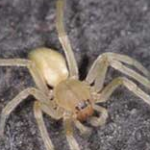
Yellow Sack Spiders
Yellow sac spiders derive their name from their yellow color and the silk tube or sac they construct to hide in during the day. They are typically less than 3/8 inch (10 mm) in length. Only two Cheiracanthium species occur in North America: Cheiracanthium inclusum, and Cheiracanthium mildei.
Yellow sac spiders are more common outdoors than indoors. Female spiders lay eggs in June and July in a loose mass. The spiderlings overwinter and become adults next May to June. They enter structures through faulty screens, loose fittings, unsealed doors, vents, utility lines, and plant materials brought inside. Inside structures, yellow sac spiders build silken retreats at upper corners of ceiling wall junctions, and in basements and crawl spaces. Outside, yellow sac spiders are found beneath loose bark, in leaf litter, and under rocks. They can also be found behind shutters, under eaves, and at corners of windows.
Yellow sac spiders are believed to cause more spider bites than any other spider in the United States. Their bites rarely result in more than localized redness and burning sensation at the site of the bite. The symptom lasts for hours to a maximum of two days.
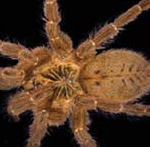
Tarantulas (Pet Spiders)
Tarantulas (Family: Theraphosidae) are often kept as pets. Tarantulas are 9–75 mm in size and typically light brown to black. The abdomen is generally clothed with blackish-colored pubescence and longer orange-buff hairs (setae). They are found in North America, South America, Europe, Africa, Australia, and southern Asia. The greatest numbers are found in South America.
In the wild, tarantulas are typically ground-dwellers living in silk-lined burrows. They are nocturnal sit-and-wait predators and are rarely found more than a few centimeters away from their burrow entrances. Most tarantulas are not very toxic. Bite reactions vary from painless to moderately or intensely painful, with reddening about the puncture site. The pain seldom persists for more than 30 minutes. Some tarantulas in Latin America, Africa, and Asia contain neurotoxins in their venom. The venom can cause severe, sometimes life-threatening reactions.
Many tarantulas possess tiny hairs on their abdomen, which are readily detached when stroked with their hind legs. The hairs cause irritation to the skin and inflammation of the eyes, mouth, and respiratory passages. Rubbing the affected areas will worsen the symptoms. People who are allergic to bee stings or spider hairs should avoid handling tarantulas. Pet tarantulas vary in their aggressiveness. People should be familiarized with their behavior before buying and handling tarantulas. A useful guide about tarantulas can be found at: tarantulaguide.com.
What does a spider bite look like?
It looks like this:

Two holes, one for each little fang. And remember…out of 20k different types, only a handful can actually puncture your skin. That’s why being able to identify which can and which cannot is so important.
Why not just squish them all…
Take a minute and 30 seconds to watch this video…one spider eats up to two thousand insects a year…insects that would otherwise be eating our crops.
By the way, if your child wants a pet spider, you don’t have to go all out with a big hairy Tarantula…find them a Jumping Spider. There’s a lot of YouTube videos on them. They have quite the personality!
Teach your children well
The last thought I want to leave you with is this…please don’t scare your children, even if you are scared. Educate them, yes, but don’t terrify them. Teach them that something as small as a spider is probably more scared of us than we are of them. Tell them that if they were lost and needed to be rescued, you would hope someone would help them…so let’s help this little guy find his way home, shall we?
RESPOND
You only need a cup and a piece of cardboard or paper to keep them from falling out of the cup once they are inside. Respond, don’t react.
Love the unloved
Being kind is never lost on a child. Every kindness we as adults can role model for them will come back 100 fold as they turn into adults. I will leave you with this beautiful poem…and may you always love the unloved things.

+++++++++++++
As always, this blog is not a replacement for sound medical advice. I am not a doctor. Please make an appointment to see your healthcare provider and put a good plan in place that works for you and the needs of your body.
That’s all I have for you this week, dear reader. I’ll see you back here next Wednesday to share another cup of coffee. Until then, be good to yourself and each other.
Mind, Body, Spirit…Osteopathic Doctors treat the whole person, not just the ailment. Is your PCP a DO? Would you like to learn more about Osteopathic Physicians? Click HERE!
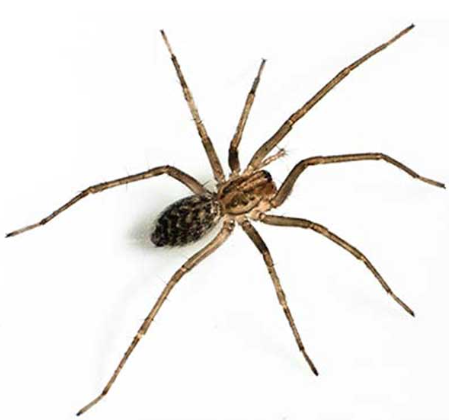
I like spiders-outside. Inside they can be useful to catch flying insects but they also weave webs or leave strands of “silk” that get on my hands and face and are not pleasant.